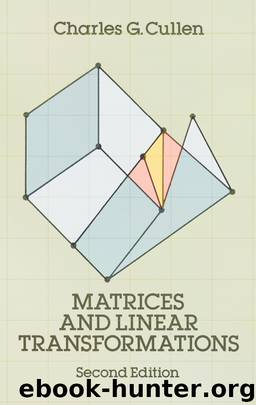Matrices and Linear Transformations by Charles G. Cullen

Author:Charles G. Cullen
Language: eng
Format: epub
Publisher: Dover Publications
Published: 1972-03-09T16:00:00+00:00
Now Crdβ(α) ≠ 0 because α ≠ 0, so it follows that λ is also a characteristic value of A and that the associated characteristic vector of A is Crdβ(α). The converse was established before Definition 4.7.
Theorem 4.11 says that characteristic values depend on the transformation and not on the basis chosen to represent it. From Theorems 4.10 and 4.11, we now have the following
Corollary Similar matrices have the same characteristic values.
If, as in Eq. (4.8), A is similar to a diagonal matrix, then we see from Eq. (4.9) that the columns of P are all characteristic vectors of A. Since P is nonsingular, the columns of P form a basis for n × 1 consisting entirely of characteristic vectors. Conversely, if such a basis exists, then it is clear that A is similar to a diagonal matrix. We have, therefore, proved Theorem 4.12.
Theorem 4.12 The n × n matrix A is similar to a diagonal matrix if and only if there exists a basis for n × 1 consisting of characteristic vectors of A.
We can restate Theorem 4.12 as a result about linear operators as follows.
Theorem 4.13 Let be an n-dimensional vector space over . The operator τ ∈ (, ) can be represented by a diagonal matrix if and only if there is a basis for consisting of characteristic vectors of τ.
It is important to observe that characteristic vectors are not unique. If α is a characteristic vector of τ ∈ (, ) [where τ(α) = λα], then it follows directly from the linearity of τ that,
Download
This site does not store any files on its server. We only index and link to content provided by other sites. Please contact the content providers to delete copyright contents if any and email us, we'll remove relevant links or contents immediately.
| Applied | Geometry & Topology |
| History | Infinity |
| Mathematical Analysis | Matrices |
| Number Systems | Popular & Elementary |
| Pure Mathematics | Reference |
| Research | Study & Teaching |
| Transformations | Trigonometry |
Modelling of Convective Heat and Mass Transfer in Rotating Flows by Igor V. Shevchuk(6391)
Weapons of Math Destruction by Cathy O'Neil(6142)
Factfulness: Ten Reasons We're Wrong About the World – and Why Things Are Better Than You Think by Hans Rosling(4693)
Descartes' Error by Antonio Damasio(3229)
A Mind For Numbers: How to Excel at Math and Science (Even If You Flunked Algebra) by Barbara Oakley(3217)
Factfulness_Ten Reasons We're Wrong About the World_and Why Things Are Better Than You Think by Hans Rosling(3197)
TCP IP by Todd Lammle(3133)
Fooled by Randomness: The Hidden Role of Chance in Life and in the Markets by Nassim Nicholas Taleb(3043)
Applied Predictive Modeling by Max Kuhn & Kjell Johnson(3018)
The Tyranny of Metrics by Jerry Z. Muller(3000)
The Book of Numbers by Peter Bentley(2908)
The Great Unknown by Marcus du Sautoy(2645)
Once Upon an Algorithm by Martin Erwig(2598)
Easy Algebra Step-by-Step by Sandra Luna McCune(2579)
Lady Luck by Kristen Ashley(2531)
Practical Guide To Principal Component Methods in R (Multivariate Analysis Book 2) by Alboukadel Kassambara(2497)
Police Exams Prep 2018-2019 by Kaplan Test Prep(2483)
All Things Reconsidered by Bill Thompson III(2355)
Linear Time-Invariant Systems, Behaviors and Modules by Ulrich Oberst & Martin Scheicher & Ingrid Scheicher(2333)
